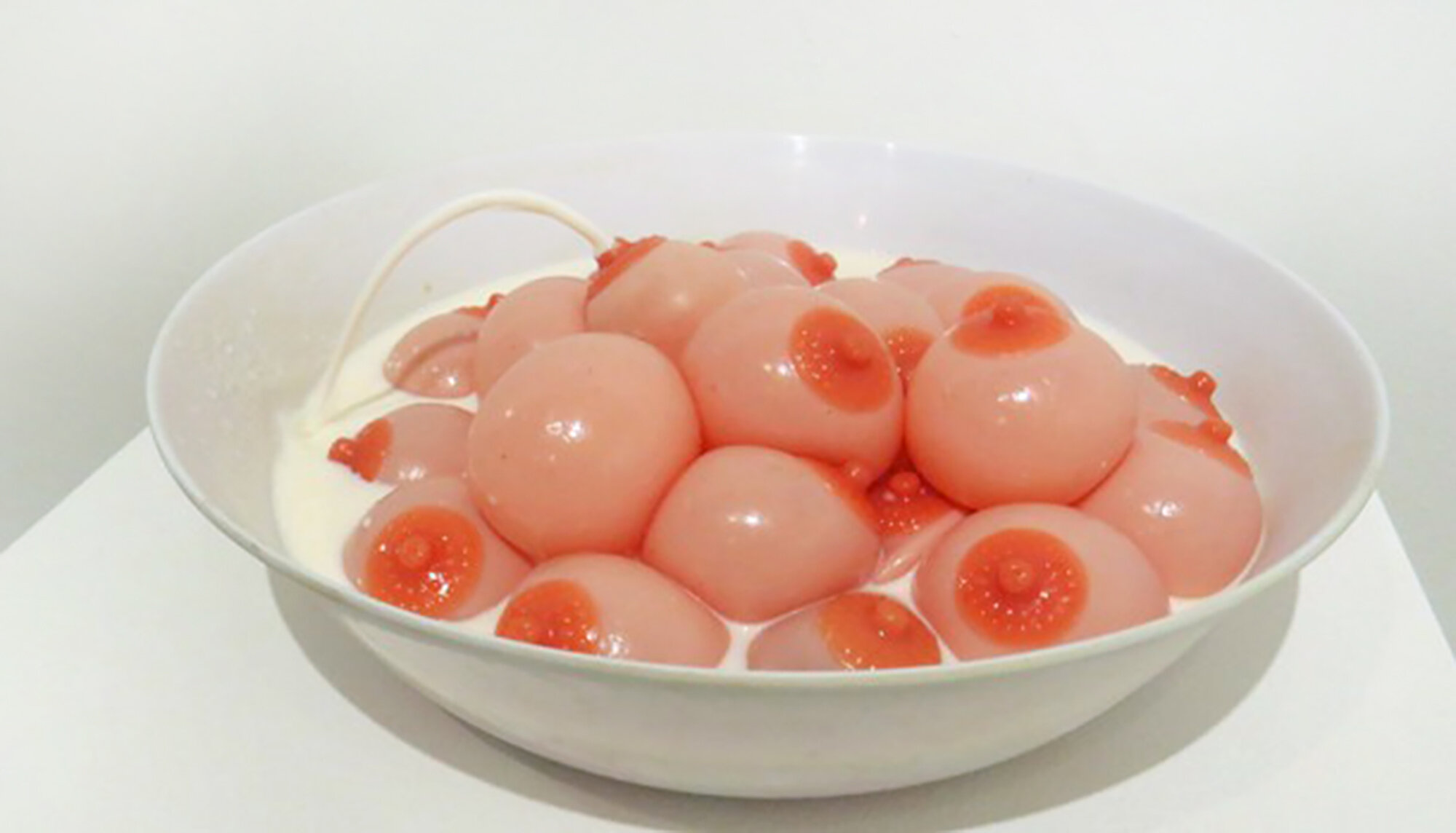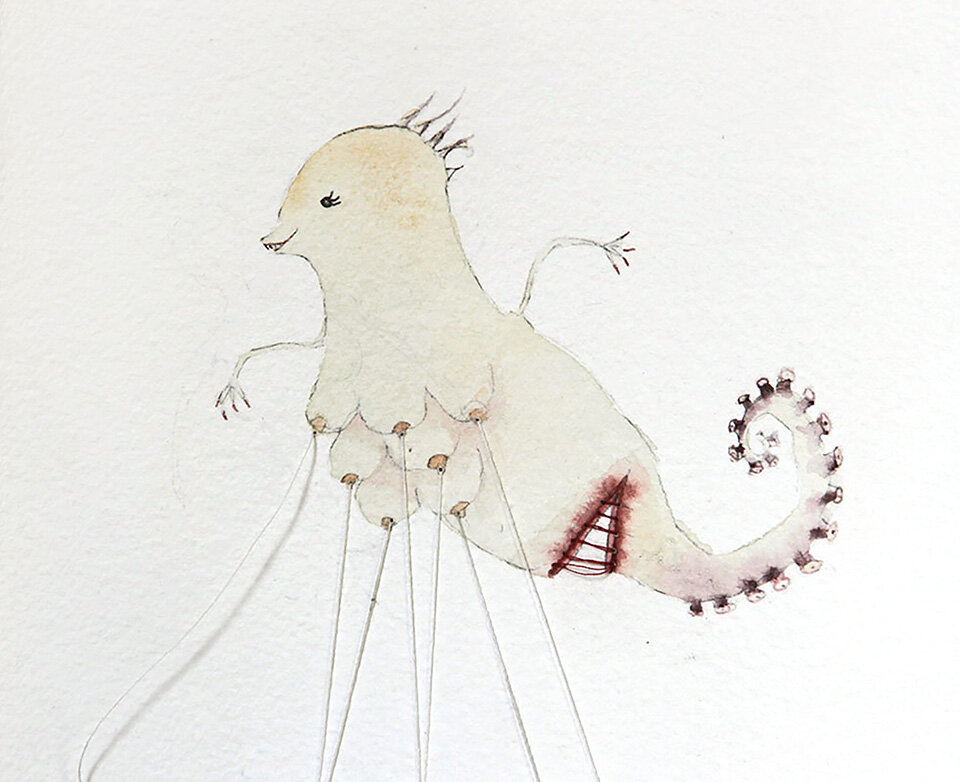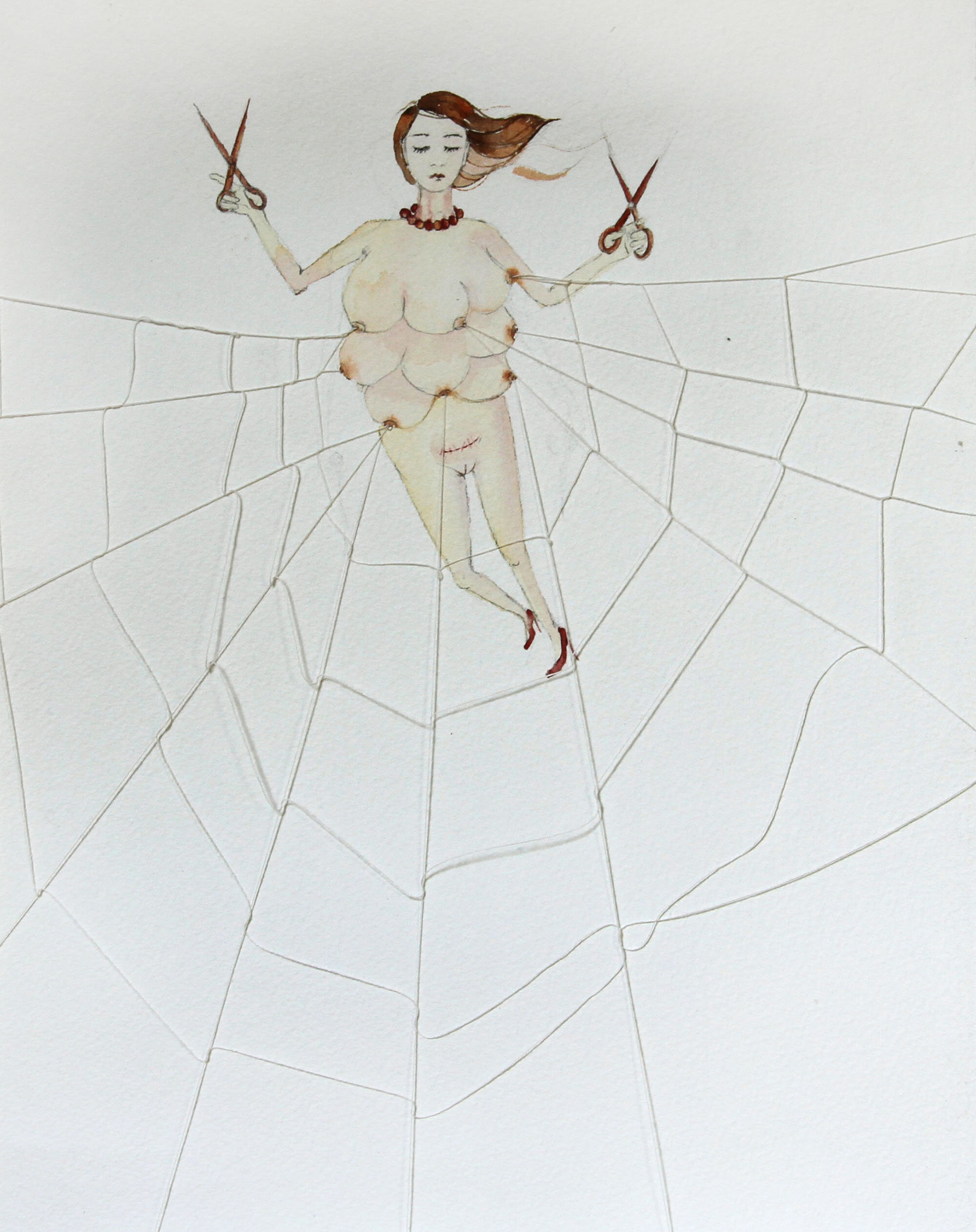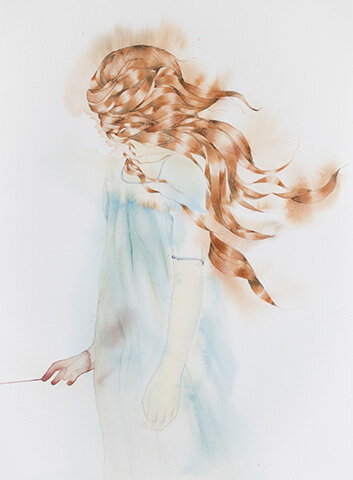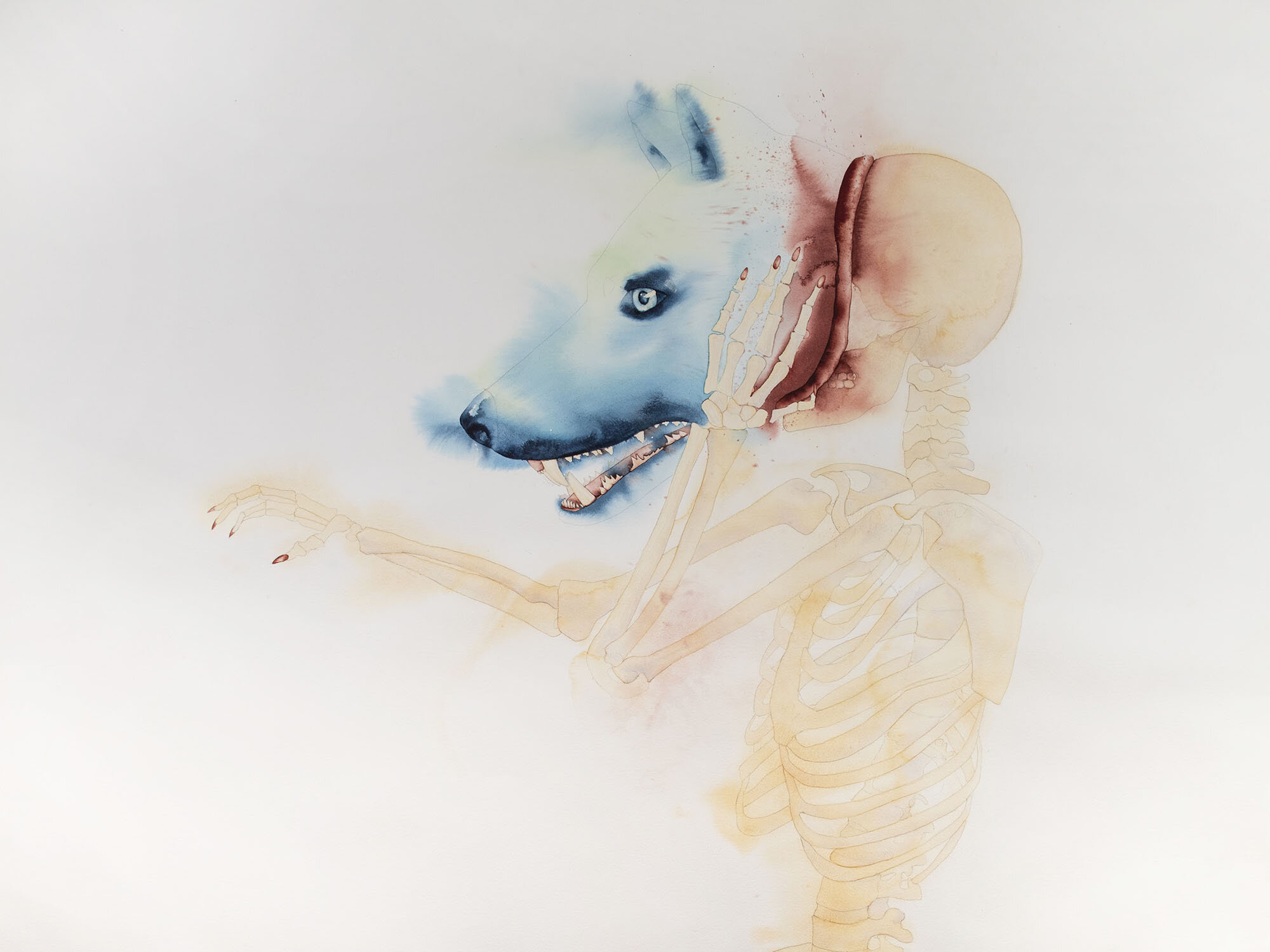El libro de la leche y El libro de la sangre, por Alejandra Alarcón
15 de diciembre 2020
Alejandra Alarcón, una precipitación
Aproximaciones a El libro de la leche y El libro de la sangre
Paola R. Senseve T.
Una mujer sin rostro me mira. Intenta tocarme, pero no tiene manos. Está fuera, de foco, de casa, en la intemperie, bajo el sol, sus cabellos surcan con el viento. Está partida en dos, es probable que no sea una mujer, que sean dos mujeres. Yo tengo rostro, yo la miro buscando. Yo tengo manos, las estiro para tocarla y sentir. Sus heridas de mujer están abiertas. ¿Qué es ser mujer? ¿Cuáles son las heridas de mujer? Esa mujer no tiene rostro, pero tiene vagina. Sus senos están inflados, de ellos brota un líquido que baja hasta unirse con otro líquido que surge desde la incisión que refrenda su maternidad. ¿Una mujer es una madre? ¿Una madre es una mujer? Si algo pasa en esta imagen, es que de repente me ha inundado. Ahora mis ojos están inmersos en un humor vítreo compuesto de leche y sangre.
El párrafo anterior corresponde a una de las piezas que componen El libro de la leche y El libro de la sangre, series de la artista boliviana Alejandra Alarcón. La reacción al observarla es semejante a una transfusión, que líquidamente te recorre hasta convertirse en ti, es decir, dos cuerpos en un solo cuerpo.
A menudo imagino a Alejandra nadando, sumergida en agua, porque sé que es una actividad que practica, pero también porque la he visto pintar. Pintar respirando con ritmo, moviéndose aparatosamente para cubrir algunas grandes superficies con todo su cuerpo, como si el aire fuera agua. Como si el papel fuera agua y el agua fuera agua y sus dedos fueran agua también. Respirar, fluir. Alejandra Alarcón entiende el agua, la defiende y la reivindica como el país donde ha decidido vivir, como su hogar, como su medio de transporte y comunicación y alimentación y amor. Y para sorpresa de algunas -no mía-, también como tema discursivo: Alejandra milita una coherencia absoluta y constante.
Asumo que esa constancia de años de trabajo ancla su fuero en que aquello que tiene cualidad líquida, por naturaleza, no entiende límites; los pelea. Entonces la obra, o la idea, o la propuesta, no está terminada. La búsqueda no acaba porque rebalsa y transmigra a otros espacios y estadios, como la vida misma, a veces difíciles de controlar. Si lo pienso bien, esa delgada línea de distinción, entre necesitar controlarlo todo para crear algo y saber que el control puede ser una simple ilusión de los sentidos, es el vértigo artístico en su máxima expresión.
Siempre me ha interesado la estética particular y fluida de Alejandra Alarcón, que incluso en performances, objetos y videos logra diluirse. Pero en realidad, lo que evita mi aridez de observadora que hace años no parpadea frente su obra, es hacia dónde sitúa su atención la artista. Ella puede, por ejemplo, mirar historias que todas conocemos, pero mostrarnos sus zonas menos desérticas. Alejandra ubica esas narraciones, les pone una gota de su liquidez encima y a través de esos lentes nos hace ver una serie de verdades posibles y alternativas. Alejandra puede también, mirar su propio cuerpo, su maternidad y elastizarla o desdibujar las líneas que la contienen, como si sus líquidos se fueran a desbordar para no ser más ella, para ser todas o absolutamente nadie.
En el agua se deforma o se refracta el sonido. En el agua se alteran la mayoría de los sentidos. Bajo el deshielo constante que es Alejandra, también se refractan y se deforman las tradiciones. La reescritura es casi un género literario del que poco se habla, mucho menos cuando quien reescribe, no lo hace escribiendo. En reescribir lo “femenino” o lo identitario, siempre hay un conflicto, una urgencia, un peligro y un acierto; probablemente, la conquista del trabajo de Alejandra Alarcón es que logra que las cuatro se tensen al mismo tiempo. Otra razón del funcionamiento de esa reescritura es lo que no estamos viendo, esa imagen que falta –lo que sabemos que va a suceder- de la que habla Pascal Quignard, pero que en ella corresponde más bien al silencio, a la importancia de eso que no se está diciendo, como en la poesía y en la música.
Fuera de lo sensorial y lo formal, lo conceptual de estos dos libros es lo fluido también. Un vehículo de símbolos ultra encriptados: tentáculos, espinas, telarañas, medias ensangrentadas, granadas, lo animal, espejos o más, que habrá que tentar leer en un mar de significancias para aprehender un poco de cada propuesta. O el devenir de las aguas, líquidos amnióticos, lágrimas, sudor, fluidos vaginales y menstruación en movimiento por los conductos corporales, las venas, lagrimales, glándulas y otros. Dos fluidos/vehículos, leche y sangre, indiscutiblemente representativos de humanidad, pero también de las imposiciones sociales construidas para los cuerpos y lo sabemos, lo sabes tú que lees y ves, lo sabe Alejandra y lo sé yo que escribo este texto, que se trata de los cuerpos de las mujeres como territorios invadidos/colonizados/narrados por masculinidades dominantes.
No es gratuita la potencia de una obra de arte cuando carga todo un aparataje de consideraciones políticas transformadoras, de conceptos -me animaría a decir universalizados- que fueron, son y seguirán siendo relevantes. No es gratuita.
Alejandra Alarcón reescribe o narra o revierte o subvierte o trabaja con arte procesos que de forma regular son producidos social y políticamente, como la descolonización o la despatriarcalización. En estos libros que no son libros -y por qué no, en el extenso de su obra en el tiempo- la autora tomó la historia formal, una que sí estaba en libros libros y la reformuló soltándola a la realidad inmediata sin mayores preámbulos.
El agua, esa sustancia. El líquido, ese estado intermedio. El agua, ese líquido, el más usual. El agua recubre el 71% de la superficie tierra. El cuerpo humano está compuesto de un 60% de agua. Filtrar ideas líquidas o de manera líquida es quizá esa estrategia fulminante que tiene el arte y que casi siempre le falta a la política. Y es ese el feminismo/política que suele ser problemático porque no es moda; es más bien una construcción lenta de imágenes, descubrimientos, asociaciones, realidades. Y es ese arte que no usa la política -la política muy pocas veces usa al arte- porque es una deconstrucción personal, lenta, genuina e inalterable que gota a gota va ahuecando la piedra, que gota a gota forma el humedal que amenaza con ser tormenta.
Esto anterior se ve con solidez extraordinaria en ambos, El libro de la leche y El libro de la sangre; pero también en los más de 15 años en los que Alejandra Alarcón hace arte con el agua de su cuerpo, del mundo y de las acuarelas.
Por último, hermanada en ese entrar y salir de libros inexistentes, metiendo y sacando agua, desmontando arquitecturas estructurales, cuestionándose la médula –que no es sólida-, me pregunto: ¿qué es lo siguiente que nos va a inundar Alejandra Alarcón?, ¿la forma de qué recipiente tomará su cuerpo?, ¿hacia qué mar desembocarán todas sus corrientes?, ¿cuándo llegará su siguiente precipitación?
Prepararé la tierra. Esperaré. Germinará vida.
Alejandra Alarcón, a precipitance
An approach to El libro de la Leche and El libro de la sangre
Paola R. Senseve T.
A faceless woman stares at me. Tries to touch me but has no hands. She is out -of focus, of the house-, in the outdoor, under the sun, flying with the wind, her hair. She’s split in two, it is likely she’s not a woman but two. I have a face; I see her, searching. I have hands, I reach out to touch her and feel. Her women wounds are open. What is it, to be a woman? What are these women wounds? That woman has no face but does have a vagina. Her breasts are swollen, liquid streams from them and down to join even more liquid streaming from her motherhood endorsed incision. Is a woman a mother too? Is a mother also a woman? If something occurs within this image is that, all of a sudden, it has flooded me. Now my eyes are immersed in vitreous humor of milk and blood.
That earlier paragraph is from one of the pieces that make up El libro de la leche and El libro de la Sangre (The Book of Milk and The Book of Blood), both series of the Bolivian artist Alejandra Alarcón. The reaction when observing her work is very similar to a transfusion; liquid quickly transforming until it becomes you; that is, two bodies in one.
Very often I imagine Alejandra swimming, submerged underwater, because I know this is an activity she practices, but also because I’ve watched her paint. She paints breathing rhythmically, moving perhaps awkwardly to cover the great surfaces with her whole body, as if the air was water. As if the paper was water; and the water was water and her fingers too, were water. Breath, flow. Alejandra Alarcón understands water; she defends and vindicates it as the country she’s decided to inhabit; as her home, her means of transport and communication, food and love. And, as surprising this may be to some -though not me-, as a discursive topic: Alejandra withholds an absolute and constant coherence.
I assume that all the years of constant work anchor her inner self in that of which is liquid by nature, and understands no boundaries; it fights them. And so her work, or the idea/proposal, is not yet finished. The search doesn’t end because it floods and migrates onto other spaces and forms, just as life itself, sometimes difficult to control. If I think about it, that thin distinctive line between needing to control everything in order to create something and knowing that such control could be a mere illusion of all senses, and this is the artistic vertigo in its maximum expression.
I’ve always been drawn to Alejandra Alarcón’s particular and fluent aesthetics; even in performances, objects and videos, her work manages to dilute itself. However, what prevents my barrenness as an observer that has not blinked in front of her work in years, is actually where the artist, she, places her attention. She can, for example, look at stories we all know, but shows us instead its more desertic regions. Alejandra locates these narratives, adds a drop of her liquidity and through those lenses she shows us a series of plausible and alternatives truths. Alejandra can as well look at her own body, her motherhood, and stretch it far as she un-draws all the lines that contain it, as if her liquid form were about to overflow and stop her from being her no more, to become every one, and no one at all.
Underwater, sounds are deformed or refracted. In the water most senses are altered. Underneath the constant melting ice that Alejandra is, traditions are also deformed and refracted. Rewriting is almost a genre on its own that no one speaks about, little less when whoever rewrites, does not do so in written form. When rewriting an identity or what is “feminine”, there is always a conflict, and urgency, a danger and an accomplishment; perhaps Alejandra’s work conquest is that she manages to have all four tense up at the same time. Another reason for why this rewriting works is what we are actually not seeing, that missing piece -what we know is about to happen-, what Pascal Quignard talks about, but in her case it corresponds instead to silence, to the importance of what is being said, just like with poetry and music.
Aside from its sensory and formal fluidity, the conceptual approach in these two books also flows easily. A vehicle of ultra encrypted symbols: tentacles, spines, spiderwebs, bloody socks, pomegranates, animality, mirrors and more, to attempt to read in a sea of significance to learn just a little with each proposal. Or the becoming of all that is water, amniotic liquids, tears, sweat, vaginal fluid and menstruation in movements through the body’s conduits, through its veins, tear glands and others. Two vehicles, milk and blood, indisputably representative of what humanity is, but also of social impositions, created for the body, and we know it; you, reading this know it and see it, Alejandra knows it and I, whilst writing this text know it, that it is about women’s bodies invaded/colonized/narrated by dominant masculinities.
The strength of a work of art is not gratuitous; specially when it carries a whole apparatus of transformative political considerations, of concepts -I’d dare to say universalized- that were, are and will continue to be relevant. It is not gratuitous.
Alejandra Alarcón rewrites, or narrates, or reverts and subverts, or works… with art processes that in a regular way are socially and politically produced, just like decolonization or depatriarchalizing. In these books that are not books -and why not, throughout her entire work- the author took the formal story, one that was in books-books and recreated it by releasing it to immediate reality without further ado.
Water, that substance. Liquid, that intermediate state/form. Water, liquid, the most common. Water covers 71% of the earth’s surface. The human body is made up of 60% of water. Filtering liquid ideas, or in a liquid way, is perhaps that fulminant strategy art has and politics lack. And this is the feminism/politics that usually is problematic because is not fashion; it is, actually more of a slow construction of images, discoveries, associations, realities. And it is that art that politics would not use -actually, politics rarely uses art- because it is a personal, slow, genuine and unaltered deconstruction, drop by drop hollowing the stone; drop by drop forming wetlands that threaten to become a storm.
This aforementioned can be seeing clearly in both, El libro de la leche en El libro de la Sangre; but it can also be seeing in the more than 15 years that Alejandra Alarcón makes art with her watery body, water of the world and that of watercolors.
Lastly, and twinned with this entering and exiting of non-existing books, getting water in and out, dismantling structural architectures, questioning herself to the unsolid core, I wonder: what will Alejandra Alarcón flood within us next? What shape will her body take? To which sea will all her currents flow to? When will the next precipitance arrive/be?
I shall prepare the ground. Waiting. Live will germinate.
Translated by Alejandra Estrada
El libro de la Leche. Videografía Alfredo Salomón. Audio Gal*in_dog, 2015
El Libro de la Sangre
Biografía de Alejandra Alarcón Rodríguez
Nace en Cochabamba, Bolivia el 4 de julio de 1976 donde estudia la licenciatura en Sociología en la Universidad Mayor de San Simón, en Cochabamba.
Llega a la ciudad de México año 2002 y realiza la Licenciatura en Artes visuales en la Escuela Nacional de Pintura, Escultura y Grabado “La Esmeralda”.
Cuenta con 16 exposiciones individuales en museos y galerías. Ha participado en más de 80 exposiciones colectivas en México, China, Italia, Francia, España, Inglaterra, Polonia, Canadá, Estados Unidos, Brasil, Perú, Chile, Colombia, Argentina y Bolivia.
Forma parte del Sistema Nacional de Creadores FONCA (México) dentro la especialidad de Artes Visuales (Pintura) 2016-2019. Beneficiaria de la beca Pollock-Krasner Foundation (2019-2020).
Biography ofAlejandra Alarcón Rodríguez
She was born in Cochabamba, Bolivia on July 4, 1976, where he studied for a degree in Sociology at the Universidad Mayor de San Simón, in Cochabamba.
She arrived in Mexico City in 2002 and completed a Bachelor of Visual Arts at the National School of Painting, Sculpture and Engraving "La Esmeralda".
It has 16 solo exhibitions in museums and galleries. She has participated in more than 80 group exhibitions in Mexico, China, Italy, France, Spain, England, Poland, Canada, the United States, Brazil, Peru, Chile, Colombia, Argentina and Bolivia.
It is part of the National System of Creators FONCA (Mexico) within the specialty of Visual Arts (Painting) 2016-2019. Recipient of the Pollock-Krasner Foundation scholarship (2019-2020).

